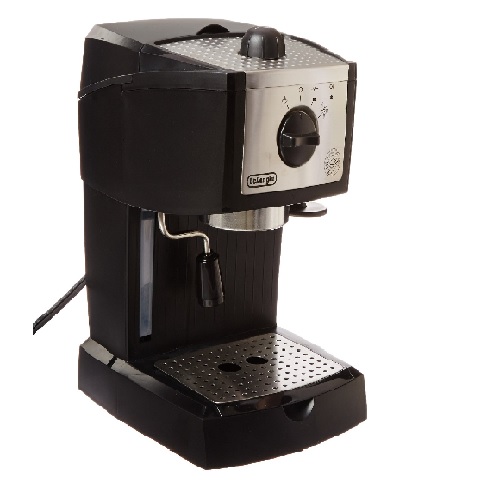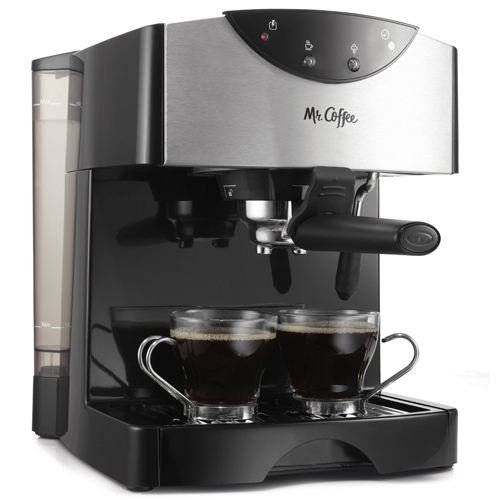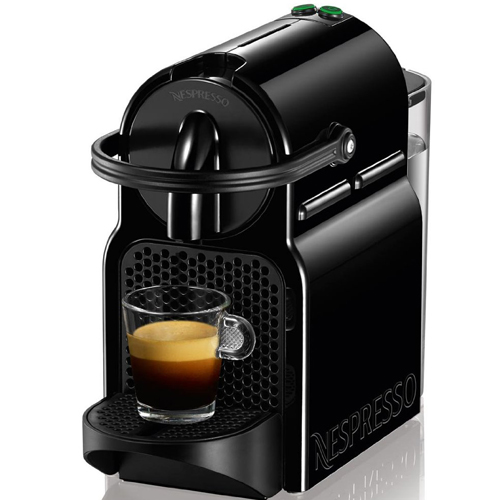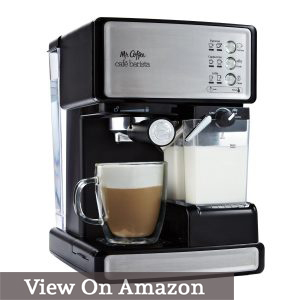
What is Expresso?
Espresso, sometimes incorrectly referred to as expresso, is a very concentrated coffee drink. The average cup of coffee is brewed by slowly adding hot water to coarsely ground beans, while espresso is a highly specialized and specific process.
Espresso is actually the result of pressurizing water and putting force against a tightly packed pod of finely ground coffee grounds. The average cup of coffee process referred to as the drip method, is not able to produce a final product nearly as concentrated as what an espresso machine can produce.
In addition, this method of creating an Espresso requires the machine operator to actually pack down, or tamper down, a pod of coffee so tight that it is no longer recognizable as coffee grounds. It actually begins to look more like a disc, similar to a hockey puck. You can neatly pack it and use even any travel kettle to make coffee anywhere you like.
Due to the highly concentrated nature of espresso, it is served in a smaller portion than the usual cup of coffee. While a traditional “cup” of coffee is approximately 5 ounces (depending on where you are served), espresso is served in “shots” of 1 ounce each. This results in a similar serving of caffeine between the two methods due to their associated sizes, usually around 150 mg.
The History of Espresso
The term espresso comes from the idea that the amount of coffee produced is expressly made for one person. This is how the modern espresso is made. The earliest known patent of an espresso machine comes from Angelo Moriondo. Patented in Turin in 1884, it actually brewed the concentrated coffee in batches, rather than individual servings.
It was not until nearly 20 years later, in 1901, that Luigi Bezzera updated and improved upon the individual design, and included the single serve process. This single-serve process allowed the espresso to be made on demand in the freshest manner possible.
The process of improving upon the original design happened several times during the next century; sometimes improving significantly and other times just by adding small features to the original design. These improvements led to what we now know as the modern espresso maker, with a variety of add-ons and features.
Today, the modern commercial espresso machine has been miniaturized in scope and reduced in both size and price for consumer use. Now, the home user can obtain a great shot of espresso by purchasing a reliable unit for under $200.
“Espresso Roast” Beans
Occasionally a coffee bean may be named an “espresso roast”. This is a misnomer, as any type of roast can be used to create an espresso. In many regions of the world, espresso is created using a darker roasted bean. Thus, several manufacturers simply use the term espresso roast as another way of saying that it is a dark roast and preferred as an espresso bean.
The Process of Producing Espresso

First, a lesser amount of water is used than in the brewing process of a traditional cup of coffee. In addition, rather than simply using hot water, the water used to brew espresso is extremely hot, often near the boiling point. This near boiling water is put under a large amount of pressure and pressed against the beans. These beans are also packed down tight into a pod. While an average cup of coffee uses coarse beans, beans used for espresso are very finely ground to encourage a more concentrated final product.
The espresso that is produced through this process is a very concentrated cup of coffee. It not only contains more caffeine per ounce, but it also contains more dissolved particles of the coffee beans and its associated nutrients contained within. This includes magnesium, and also B vitamins such as niacin and riboflavin, which can be used for best body detox. Because of this, espresso also has a much stronger flavor than the average cup of joe brewed in a coffee pot or a french press.
The top of a serving of espresso is usually foamy or creamy. This is referred to as crema. It comes from the emulsification of the oils in the coffee into a colloid, which is a suspension of particles similar to milk. Espresso is the only brewed coffee process that produces a crema.
You may have heard of some of these coffee drinks: caffe latte, Caffe macchiato, Caffe mocha, Caffe Americano, or a flat white. These are all used with espresso as their base. These specialty coffee drinks can be easily created at home with an inexpensive espresso machine.
Save Money By Creating Espresso At Home
Espresso is one of the most popular coffee drinks in the world. It’s most common form at the popular coffee shop Starbucks, a doppio (two shots of espresso) will run cost you $2. Most who shop there for a morning espresso spend a minimum of $2 per doppio, 5 days a week, 50 weeks per year. This adds up to a staggering price tag of $500 a year just for a simple doppio. And it doesn’t stop there.
When is the last time that you stopped at Starbucks and just bought a simple espresso? More often than not, it is easy to fall into the trap of not making breakfast at home and simply grabbing a sandwich or lunch box from the store. Usually costing $6 per lunch box, that adds up to more than $1500 per year, not including the $500 cost for the espresso. And that is assuming that you will only get a doppio, not a more expensive style of coffee drink. After all, you are already there, so why not?
Clearly, the price tag is not worth it. Even millionaires knew that the secret to becoming wealthy and staying wealthy, is to simply not spend money that you don’t need to spend. A dollar not spent is a dollar that you do not have to earn. This is often repeated in the adage “a penny saved is a penny earned.”
For $200 or less, an espresso machine that sits on your counter at home and can be used any time at your convenience will save the average coffee drinker the price of initial investment many times over. You must also think about the implications of more than one family member spending daily money at a location like Starbucks.
Before You Buy
In order to pick your best espresso machine under 200 bucks, first, it is important to understand the different types of espresso machines available for purchase. This is due to the drive mechanism that pressurizes and pushes the extremely hot water through a serving of finely ground beans. There are four types of mechanisms used to create espresso:
- Steam driven
- Piston driven
- Pump driven
- Air pump driven
Steam Driven Espresso Machines
The steam driven espresso machine is just as its name implies. Steam is used to attain a high enough amount of pressure to drive the water through the ground beans. Steam-driven espresso machines are what the original patent from Angelo Moriondo was based upon. The lack of expense associated with steam driven machines is due to a lack of moving parts. The cost is low while remaining effective.
Piston Driven Espresso Machines
Also known as lever driven, this machine was created in 1945 by Achille Gaggia of Italy. You may recognize his name from the brand of espresso machines, Gaggia. Rather than using an effortless force to drive the pressure, as the steam machine does, the user pulls on a lever to drive the pressure mechanism.
Piston driven espresso machines are where the common terminology of pulling a shot comes from, as you literally pull on the lever to produce the shot of espresso. Some piston driven machines are fully manual. Others are semi-manual, utilizing a spring that the lever acts upon to reduce the force necessary to pull the shot.
Pump Driven Espresso Machines
Pump driven espresso machines are the most commonly used type of espresso machine in the commercial coffee scene. It is an improved version of the piston driven design. Rather than requiring the user to pull with force upon the level, a pump driven by a motor provides the energy to do the work for them. The pump is electrically driven and requires great precision in order to work properly.
Four types of pump driven espresso machines are available:
- The Single Boiler
- The Singer Boiler Dual Use
- The Heat Exchanger
- The Dual Boiler
The Single Boiler Pump Driven Espresso Machine
The single boiler pump driven espresso machine, also known as an SB, can brew espresso, however, cannot create steam, making them less common. They are the most inexpensive home models available for purchase.
The Single Boiler Dual Use Pump Driven Espresso Machine
The single boiler dual use pump driven espresso machine, also known as an SB/DU, use one chamber to boil the liquid, but can operate with two functions. They can both boil water and drive it through the beans for creating the espresso, and also create steam from boiling to add to it. However, the SB/DU machine cannot do both at the same time. These are created for the espresso hobbyist who wants to experiment with different types of espresso related drinks that require steam but does not want to spend a lot of money.
The Heat Exchanger Pump Driven Espresso Machine
The heat exchange pump driven espresso machine, also known as an HX, is similar to the SB/DU machine. The difference is, with an SB/DU machine, there is a time delay required between the use of the single boiler for creating steam and for heating the water.
This is because the steam must be brought to a higher temperature than the heated water, therefore requiring a period of time to bring the machine to the proper temperature for its dual use. This can actually take a few minutes, meanwhile, your espresso shot may get cool while waiting for the steam, or vice versa.
In contrast, the HX requires just around 5 seconds to cross over between steaming and heating functions. This is what is referred to by the name heat exchanger, hence the nickname HX. A cool flush of liquid goes through the machine after creating the steam, allowing near instantaneous switch of functions, as compared to minutes for the SB/DU.
The Dual Boiler Pump Driven Espresso Machine
Found almost exclusively in the high-end home models, as well as commercially available machines, the dual boiler pump is driven espresso machine, also known as a DB, is the best of both worlds. It contains two separate boilers for the water, thus allowing production of either steam or heated water without a time delay. You may be able to find the lower end home user DB models in a similar price range as the higher end HX models.
The Air Pump Driven Espresso Machine
The last type of pump driven espresso machine we will be discussing is the air pump driven, model. The AP style espresso machine is relatively new to the scene. Rather than using a traditional pump, the air pump machine uses compressed air, like Carbon Dioxide or Nitrogen gas, to drive water through the beans. This is the style used in the AeroPress, the first air pump is driven model which appeared in 2005.
Recommended Best Espresso Machine Under 200 $ (Our Best Picks)
You made it! So far, you have learned what espresso is, its history, the process of making it, and the types of espresso machine mechanisms available. Now is the fun part: picking out a model to get for your house! It’s an amazing time that we live in where we can get cafe quality espresso for a fraction of the cost getting one at the local coffee shop.
We have researched and researched, comparing and contrasting the best and highest quality home use espresso machines that cost under $200 (Last Update At 13/9/2018). To make simplify your process of choosing which one to get, we have broken down each model into 4 easy to understand criteria, along with its associated pros and cons. Here we go!

- Product
- Our Editor Rating
- Verified Purchaser Review
- Price
- In-Depth Review (Recommended)
- Pros/Cons

De'Longhi EC155 15 BAR Pump Espresso and Cappuccino Maker- READ BELOW


Mr. Coffee Cafe Barista Espresso Maker with Automatic milk frother- READ BELOW

Mr. Coffee ECMP50 Espresso Cappuccino Maker, Black- READ BELOW
 Nespresso Inissia Espresso Maker, Black
Nespresso Inissia Espresso Maker, Black
Price: Check Price On Amazon
Appearance
Black body with black face; other colors available for the body at slightly higher price points.
Drive Mechanism
Pump.
Features
- Uses Capsule pods, similar to a K-Cup.
- 25 second pre-heating time.
- Two modes: espresso and lungo
- Removable 24 ounce water tank.
- Energy efficient auto shut off after 9 minutes of nonuse.
 Nespresso Pixie Espresso Maker, Electric Titan
Nespresso Pixie Espresso Maker, Electric Titan
Price : Check Price On Amazon
Appearance
Black top and underside; metal front and side panels.
Drive Mechanism
Pump.
Features
- Uses Nestle capsule pods.
- Thermoblock heating element.
- 30 second pre-heating time.
- Creates both espresso shots and cups of lungo.
- Removable 24 ounce water tank with backlit LED water level detectors.
- Energy efficient auto shut off after a lack of activity.
- Power cord storage.
- Folding drip tray for larger cups, along with additional programming you can set to fill them.
 Mr. Coffee ECMP50 Espresso/Cappuccino Maker, Black
Mr. Coffee ECMP50 Espresso/Cappuccino Maker, Black
Price : Check Price On Amazon
Appearance
Black lower body, metal upper face.
Drive Mechanism
Pump.
Features
- Manually packed pod system.
- Dual shot brewing system allows you to make two shots simultaneously.
- External arm to add froth.
- 40 Ounce water tank.
- Ready-to-brew indicator light.
- Single and double shot filter included.
Mr. Coffee Cafe Barista Espresso Maker with Automatic milk frother, BVMC-ECMP1000
Price : Check Price On Amazon
Appearance
Stainless steel front with an overall black body.
Drive Mechanism
Pump.
Features
- Simple one touch control panel.
- Automatic milk frother.
- Adjustable Cup Tray.
- Removable water tank.
- Removable drip catch.
- Comes with both single and double shot filters.
- Includes a scoop, tamper, and recipes for using the machine.
 De’Longhi EC155 15 BAR Pump Espresso and Cappuccino Maker
De’Longhi EC155 15 BAR Pump Espresso and Cappuccino Maker
Price :
Check Price On Amazon
Appearance
Black body with metal face.
Drive Mechanism
Pump.
Features
- Uses store bought single-use pods or reusable containers.
- Espresso, cappuccino, and latte modes.
- Two thermostats for water prep and steam prep.
- Stainless steel boiler.
- Removable water tank.
Decision Time

Well folks, there you have it! We gathered information on all of the available best espresso machines under 200 bucks to ensure that you made the best decision for you.
Friends or coworkers may try to steer you one way or another, but that way of deciding is filled with subjective opinions and anecdotal evidence. Our well researched and thoughtfully explained guide aims to remove subjective opinions and to help you base your decision on objective factors.
After scouring through all available information from manufacturers, we boiled (or steamed, as it were!) down the list to our favorite and most recommended models. Then, we decided on the most objective factors to weigh and measure. This included the price, the appearance, the features, and the pros and cons of each device.
Now, it’s up to you! You are armed with all of the knowledge and know how to pick out the perfect espresso maker for your particular situation. Whether that is purely by price, or by included specialized features like frothing wands or dual boilers, that is for you to decide.
Which one will you choose?








